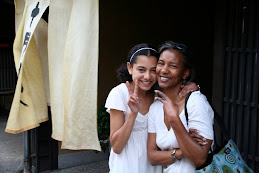
OK, it's not a flip book, but it's the next best thing. Here's a quick spin through our favorite memories of China in pictures (on Flickr). For best viewing, click "slideshow" mode (link in upper right hand corner).






 Imagine a massive man made lake carved out of the flat Beijing earth 900 years ago. Imagine an equally incomprehensible man-made hill (made from the dredgings from the lake) with a palace sitting atop it. Imagine an adjoining covered promenade so long that over 10,000 individual paintings adorn its beams and roof. Imagine a solid marble boat sitting on the lake, massive lake worn stones on pedestals and dragon boats dotting this lake (Kunming Lake).
Imagine a massive man made lake carved out of the flat Beijing earth 900 years ago. Imagine an equally incomprehensible man-made hill (made from the dredgings from the lake) with a palace sitting atop it. Imagine an adjoining covered promenade so long that over 10,000 individual paintings adorn its beams and roof. Imagine a solid marble boat sitting on the lake, massive lake worn stones on pedestals and dragon boats dotting this lake (Kunming Lake). 
 Watching Beijing come to life in the early morning is like watching an orchestra warm up. Each little vignette is like a part of the city tuning itself for the day. David rented a bike and got in a couple of hours of eavesdropping on the avenues and hutongs (a lane) of this noble capital city before breakfast. What a grand symphony.
Watching Beijing come to life in the early morning is like watching an orchestra warm up. Each little vignette is like a part of the city tuning itself for the day. David rented a bike and got in a couple of hours of eavesdropping on the avenues and hutongs (a lane) of this noble capital city before breakfast. What a grand symphony. Workers casually pedal their bikes to work (bikers are a bit more civil in Beijing than Shanghai). A man and a woman prepare and fry dough in their sidewalk stand. An elderly man in a bright red cap takes his mina birds out in their cages for their morning “ni haos” beside Ho Hai Lake. A half-dozen swimmers ease into the breast-stroke across Ho Hai. Three woman practice a form of Tai Chi with brilliant Red and yellow fans in their right hands snapping them crisply at every turn. Bike-drawn wagons haul their loads of leeks and melons to a nearby market. Gymnasts swing on the outdoor gymnasium by the Lake. Ping pong games are played a few feet away on concrete tables. Construction workers on nearly every block repair curbstones, walls,
Workers casually pedal their bikes to work (bikers are a bit more civil in Beijing than Shanghai). A man and a woman prepare and fry dough in their sidewalk stand. An elderly man in a bright red cap takes his mina birds out in their cages for their morning “ni haos” beside Ho Hai Lake. A half-dozen swimmers ease into the breast-stroke across Ho Hai. Three woman practice a form of Tai Chi with brilliant Red and yellow fans in their right hands snapping them crisply at every turn. Bike-drawn wagons haul their loads of leeks and melons to a nearby market. Gymnasts swing on the outdoor gymnasium by the Lake. Ping pong games are played a few feet away on concrete tables. Construction workers on nearly every block repair curbstones, walls, pavement, rooftops and storefronts. Restaurant workers grab a smoke on a sidewalk plaza before heading into their kitchens. A woman carriers a spectacular display of pink lilies to her office. Octogenarians sit on benches in the shiny, renovated parks watching this orchestra play itself out. You can almost hear the soundtrack in the background… have a look.
pavement, rooftops and storefronts. Restaurant workers grab a smoke on a sidewalk plaza before heading into their kitchens. A woman carriers a spectacular display of pink lilies to her office. Octogenarians sit on benches in the shiny, renovated parks watching this orchestra play itself out. You can almost hear the soundtrack in the background… have a look.
 If you've been reading the blog and gotten this far, you may have been wondering, "when are they getting to Mutianyu..." or "what's Mutianyu?" or "couldn't they have come up with a better name for the blog?" Well today, the mystery that is Mutianyu was answered (at least for us)... sort of.
If you've been reading the blog and gotten this far, you may have been wondering, "when are they getting to Mutianyu..." or "what's Mutianyu?" or "couldn't they have come up with a better name for the blog?" Well today, the mystery that is Mutianyu was answered (at least for us)... sort of. To get a feel for how grand this wall is, we had to set out on a hike along it (after a fun chairlift up to the wall from down below). In this section the wall rises and falls over steep terrain so it's a jumble of steps and steep climbs made even more challenging by the slick surface. But we had a ball hiking from observation tower to observation tower (we made it to eight) over about 1 and 1/2 hours. You can only begin to get a sense of the ridiculous scale of this barrier to defend against the old enemies to the north. But we did our best. Finally, Mutianyu. Wahoo!
To get a feel for how grand this wall is, we had to set out on a hike along it (after a fun chairlift up to the wall from down below). In this section the wall rises and falls over steep terrain so it's a jumble of steps and steep climbs made even more challenging by the slick surface. But we had a ball hiking from observation tower to observation tower (we made it to eight) over about 1 and 1/2 hours. You can only begin to get a sense of the ridiculous scale of this barrier to defend against the old enemies to the north. But we did our best. Finally, Mutianyu. Wahoo!
 Our day started with a visit to one of the wonders of the world and ended with a wonderful bit of traveler's good fortune. We started the day at Tiananman Square before heading into the Forbidden City - the home of China's Emperors for over half a millenium. This jewel is located in the center of Beijing, because the "center" is always the best place to be if you are the Emperor. It has survived over 600 years of emperors, dynasties, wars, political movements and the elements. Recently renovated for the upcoming Olympics, this treasure literally sparkled. We have another fabulous guide named Joanna (Wang Meng) who really gets how we like to travel and is teaching us many fascinating things about the Ming and Qing dynasties and the more recent days of the Republic and the current leadership. Wang Men's husband is also into anime, so this makes her a big hit with Jesse! Our favorite story of the City is how the paranoid emperors built the brick city floor 15 layers deep (!) so enemies couldn't tunnel up to attack them from below! See some highlights from the Forbidden City and the Temple of Heaven here (includes a few photos from my last trip, which actually was a sunny day!).
Our day started with a visit to one of the wonders of the world and ended with a wonderful bit of traveler's good fortune. We started the day at Tiananman Square before heading into the Forbidden City - the home of China's Emperors for over half a millenium. This jewel is located in the center of Beijing, because the "center" is always the best place to be if you are the Emperor. It has survived over 600 years of emperors, dynasties, wars, political movements and the elements. Recently renovated for the upcoming Olympics, this treasure literally sparkled. We have another fabulous guide named Joanna (Wang Meng) who really gets how we like to travel and is teaching us many fascinating things about the Ming and Qing dynasties and the more recent days of the Republic and the current leadership. Wang Men's husband is also into anime, so this makes her a big hit with Jesse! Our favorite story of the City is how the paranoid emperors built the brick city floor 15 layers deep (!) so enemies couldn't tunnel up to attack them from below! See some highlights from the Forbidden City and the Temple of Heaven here (includes a few photos from my last trip, which actually was a sunny day!).


 We have been fortunate to have a few great guides on our China journey, but the task in Xian may have been the most demanding. Xian (formerly Changan) is the cradle of Chinese civilization. Our amazingly learned, kind and funny guide Jessica (a.k.a. Ren Wen Tin or Ting Ting as her mother calls her) made our short trip to Xian feel like a journey all by itself.
We have been fortunate to have a few great guides on our China journey, but the task in Xian may have been the most demanding. Xian (formerly Changan) is the cradle of Chinese civilization. Our amazingly learned, kind and funny guide Jessica (a.k.a. Ren Wen Tin or Ting Ting as her mother calls her) made our short trip to Xian feel like a journey all by itself.
 OK, I mentioned the traffic in an earlier post but I don't think I gave a clear enough picture. Traffic here is downright scary. Until recently China was not a very wealthy country. Most people got around by bicycle. Many people are still on bicycles or scooters, but now there's a rapidly growing middle class and the first thing many people do to show off their new status is buy a car. Don't forget, this is a big place - the "smaller city" we visited had 6 million people. Now add all these new cars to the multitude of pedestrians, buses, and the construction that seems to be everywhere, and what you've got is a hot mess.
OK, I mentioned the traffic in an earlier post but I don't think I gave a clear enough picture. Traffic here is downright scary. Until recently China was not a very wealthy country. Most people got around by bicycle. Many people are still on bicycles or scooters, but now there's a rapidly growing middle class and the first thing many people do to show off their new status is buy a car. Don't forget, this is a big place - the "smaller city" we visited had 6 million people. Now add all these new cars to the multitude of pedestrians, buses, and the construction that seems to be everywhere, and what you've got is a hot mess.


 China and Singapore have partnered to build a brand new city adjacent to the old city of Suzhou. The new city (which you can see pictured here from our hotel window) is comprised of high-rise after high-rise and multi-national factory after multi-national factory. The development actually reminded me of Singapore, because it was crisp, clean, and on a massive scale. It included many public spaces and giant whimsical sculptures. Shopping malls dot the spaces between the buildings with an array of restaurants from Thai to Korean to Japanese to many styles of Chinese. The buildings have been adorned with elaborate light systems to create psychedelic light shows after the sun goes down.
China and Singapore have partnered to build a brand new city adjacent to the old city of Suzhou. The new city (which you can see pictured here from our hotel window) is comprised of high-rise after high-rise and multi-national factory after multi-national factory. The development actually reminded me of Singapore, because it was crisp, clean, and on a massive scale. It included many public spaces and giant whimsical sculptures. Shopping malls dot the spaces between the buildings with an array of restaurants from Thai to Korean to Japanese to many styles of Chinese. The buildings have been adorned with elaborate light systems to create psychedelic light shows after the sun goes down.


 nd gardens of Suzhou. A boatman took us on a casual spin through Suzhou's canals with the fish-tail motion of his lone stern-mounted oar. The rain pattered all around us as we passed homes and slid under bridges that were as many as hundreds of years old. To cap it off, he sang a song in the local dialect that celebrated the beauty of Suzhou. This moment was one of the more memorable of our trip to date.
nd gardens of Suzhou. A boatman took us on a casual spin through Suzhou's canals with the fish-tail motion of his lone stern-mounted oar. The rain pattered all around us as we passed homes and slid under bridges that were as many as hundreds of years old. To cap it off, he sang a song in the local dialect that celebrated the beauty of Suzhou. This moment was one of the more memorable of our trip to date.

 The Shanghai skyline on the east side of the Huangpu River sprouted up over the last 10-15 years. It's almost incomprehensible. Many of the scuptures on the ground floor exhibition hall of the Shanghai museum have been around for 2000 years.
The Shanghai skyline on the east side of the Huangpu River sprouted up over the last 10-15 years. It's almost incomprehensible. Many of the scuptures on the ground floor exhibition hall of the Shanghai museum have been around for 2000 years. 

 It's fascinating and energizing. Today was a day for many of the city's most popular sites thanks to Zhang Fan (Rebecca) our wonderful, all-business local guide. The sites included: the jade Buddha temple, Yu Yuan garden, the Bund, the Jin Mao Tower and Chinese acrobats, but the highlight was having lunch with old friend Pete (David's college buddy), who just happened to be flying through Shanghai today. The Xiao Long Bao (small steamed pork buns) fit the theme of the day. They're an old Shanghai standby, but new to us. Perfect!
It's fascinating and energizing. Today was a day for many of the city's most popular sites thanks to Zhang Fan (Rebecca) our wonderful, all-business local guide. The sites included: the jade Buddha temple, Yu Yuan garden, the Bund, the Jin Mao Tower and Chinese acrobats, but the highlight was having lunch with old friend Pete (David's college buddy), who just happened to be flying through Shanghai today. The Xiao Long Bao (small steamed pork buns) fit the theme of the day. They're an old Shanghai standby, but new to us. Perfect!






 Here's proof that DAR is actually OTT (on this trip). This lovely photo was taken by Taryn in the one of the rarest of gems in Kanazawa that is Kenrokuen gardens. The iris and bridge, on the other hand, were shot by the tall guy. We learned from a local guide who we met at lunch that Kenrokuen was so named because of the six attributes of the perfect landscape: spaciousness, seclusion, artifice, antiquity, watercourses and panorama. With that in mind, I think I'm going to have to re-do our Bonita Avenue garden (on the roof).
Here's proof that DAR is actually OTT (on this trip). This lovely photo was taken by Taryn in the one of the rarest of gems in Kanazawa that is Kenrokuen gardens. The iris and bridge, on the other hand, were shot by the tall guy. We learned from a local guide who we met at lunch that Kenrokuen was so named because of the six attributes of the perfect landscape: spaciousness, seclusion, artifice, antiquity, watercourses and panorama. With that in mind, I think I'm going to have to re-do our Bonita Avenue garden (on the roof).


 Now in Kanazawa, on the west coast of Japan, we are enjoying a remarkable window into the country's past. The Higashi-Chaya District is home to Geisha houses that still stand close to 200 years after their establishment. Impeccably restored in some places, aged beautifully in others, you can still feel the spirit of the skill and artistry of a Geisha. Here's a peek into this wondrous world.
Now in Kanazawa, on the west coast of Japan, we are enjoying a remarkable window into the country's past. The Higashi-Chaya District is home to Geisha houses that still stand close to 200 years after their establishment. Impeccably restored in some places, aged beautifully in others, you can still feel the spirit of the skill and artistry of a Geisha. Here's a peek into this wondrous world.











